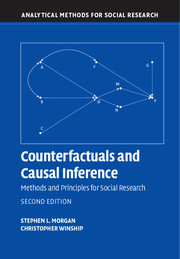Refine listing
Actions for selected content:
1437 results in Ebooks in machine learning
2 - Statistical models and inference
-
- Book:
- Core Statistics
- Published online:
- 05 April 2015
- Print publication:
- 02 April 2015, pp 19-48
-
- Chapter
- Export citation
6 - Bayesian computation
-
- Book:
- Core Statistics
- Published online:
- 05 April 2015
- Print publication:
- 02 April 2015, pp 133-183
-
- Chapter
- Export citation
5 - Numerical maximum likelihood estimation
-
- Book:
- Core Statistics
- Published online:
- 05 April 2015
- Print publication:
- 02 April 2015, pp 89-132
-
- Chapter
- Export citation

Counterfactuals and Causal Inference
- Methods and Principles for Social Research
-
- Published online:
- 05 December 2014
- Print publication:
- 17 November 2014
3 - Causal Graphs
-
- Book:
- Counterfactuals and Causal Inference
- Published online:
- 05 December 2014
- Print publication:
- 17 November 2014, pp 77-102
-
- Chapter
- Export citation
VI - Conclusions
-
- Book:
- Counterfactuals and Causal Inference
- Published online:
- 05 December 2014
- Print publication:
- 17 November 2014, pp 435-436
-
- Chapter
- Export citation
Frontmatter
-
- Book:
- Counterfactuals and Causal Inference
- Published online:
- 05 December 2014
- Print publication:
- 17 November 2014, pp i-vi
-
- Chapter
- Export citation
References
-
- Book:
- Counterfactuals and Causal Inference
- Published online:
- 05 December 2014
- Print publication:
- 17 November 2014, pp 451-496
-
- Chapter
- Export citation
III - Estimating Causal Effects by Conditioning on Observed Variables to Block Back-Door Paths
-
- Book:
- Counterfactuals and Causal Inference
- Published online:
- 05 December 2014
- Print publication:
- 17 November 2014, pp 103-104
-
- Chapter
- Export citation
6 - Regression Estimators of Causal Effects
-
- Book:
- Counterfactuals and Causal Inference
- Published online:
- 05 December 2014
- Print publication:
- 17 November 2014, pp 188-225
-
- Chapter
- Export citation
V - Estimation When Causal Effects Are Not Point-Identified by Observables
-
- Book:
- Counterfactuals and Causal Inference
- Published online:
- 05 December 2014
- Print publication:
- 17 November 2014, pp 417-418
-
- Chapter
- Export citation
9 - Instrumental Variable Estimators of Causal Effects
-
- Book:
- Counterfactuals and Causal Inference
- Published online:
- 05 December 2014
- Print publication:
- 17 November 2014, pp 291-324
-
- Chapter
- Export citation
Dedication
-
- Book:
- Counterfactuals and Causal Inference
- Published online:
- 05 December 2014
- Print publication:
- 17 November 2014, pp vii-viii
-
- Chapter
- Export citation
IV - Estimating Causal Effects When Back-Door Conditioning Is Ineffective
-
- Book:
- Counterfactuals and Causal Inference
- Published online:
- 05 December 2014
- Print publication:
- 17 November 2014, pp 265-266
-
- Chapter
- Export citation
List of Figures
-
- Book:
- Counterfactuals and Causal Inference
- Published online:
- 05 December 2014
- Print publication:
- 17 November 2014, pp xiii-xvi
-
- Chapter
- Export citation
List of Tables
-
- Book:
- Counterfactuals and Causal Inference
- Published online:
- 05 December 2014
- Print publication:
- 17 November 2014, pp xvii-xx
-
- Chapter
- Export citation
Index
-
- Book:
- Counterfactuals and Causal Inference
- Published online:
- 05 December 2014
- Print publication:
- 17 November 2014, pp 497-499
-
- Chapter
- Export citation
4 - Models of Causal Exposure and Identification Criteria for Conditioning Estimators
-
- Book:
- Counterfactuals and Causal Inference
- Published online:
- 05 December 2014
- Print publication:
- 17 November 2014, pp 105-139
-
- Chapter
- Export citation
Acknowledgments for Second Edition
-
- Book:
- Counterfactuals and Causal Inference
- Published online:
- 05 December 2014
- Print publication:
- 17 November 2014, pp xxiii-xxiv
-
- Chapter
- Export citation
Contents
-
- Book:
- Counterfactuals and Causal Inference
- Published online:
- 05 December 2014
- Print publication:
- 17 November 2014, pp ix-xii
-
- Chapter
- Export citation
